As soon as the main garden at the front of the house was planted my thoughts turned to getting even more native plants established around the margins of the forest. It’s a daunting prospect because there’s so much ground to cover but I’ve got years to work at it. I suppose planting that much nursery stock would surely cost a bundle. I had to come up with another plan.
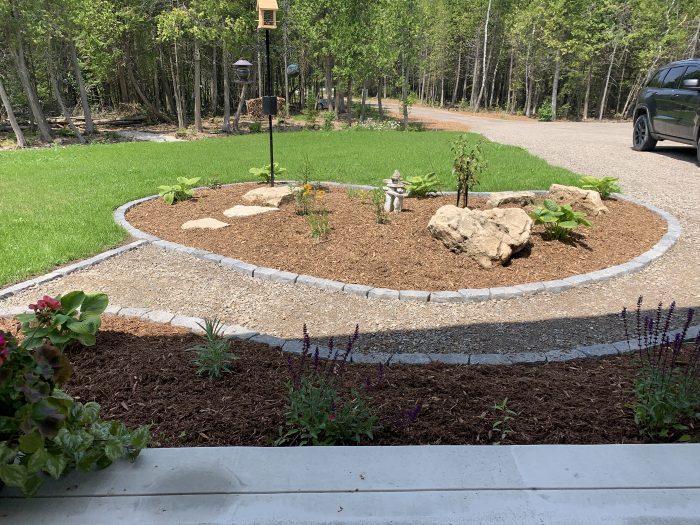
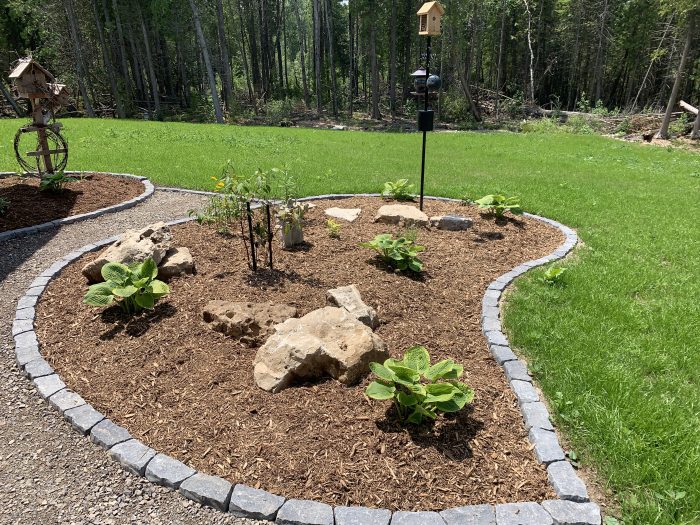
That’s where seeds come in! A package of native seeds will provide me with many plants for a fraction of the price of one nursery plant. Considering that these plants will be in a less conspicuous area (more natural and not right at the front door) I figure it’s worth a try. Not only is intentionally landscaping with native plants new territory for me but landscaping from seeds is completely foreign! It’s a good thing I’m always up for some good ole’ fashioned learning.
It’s funny: now that I’m thinking about it, I’ve never considered starting any non-native plants by seed. Somehow though, growing native plants from seed seems so … natural! Let me share how I’m getting started using seeds to plant my native landscape!
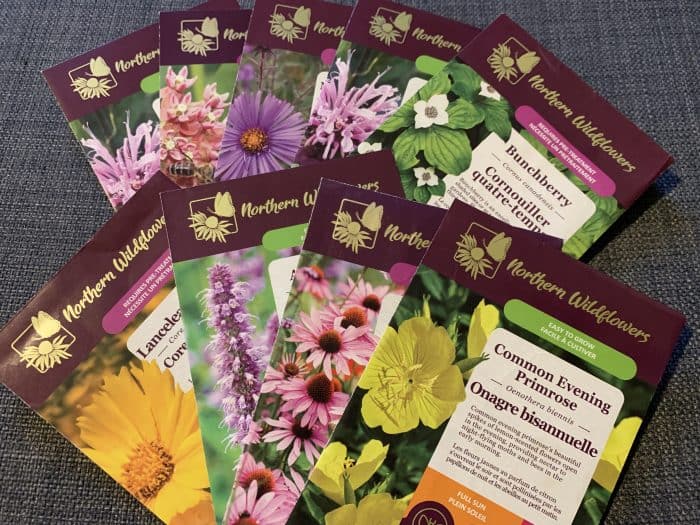
I can recall – waaaay back when I was a child – my mom’s excitement when, in the depths of winter, the seed catalogues would come in. I’d flip through the glossy pages and dream of all the possible things we could grow. Mom, however, would be more practical and search only for the seed varieties that would be the most reliable fruit and vegetable producers to feed her large family. While I will be planting fruit and vegetable gardens, my focus now is on the “pretty” things. The draw of the seed catalogue is still strong as it evokes dreams and so many possibilities!
Fortunately, now, there’s no need to wait for seed catalogues to come in. Now there’s a world of seed suppliers online and at your fingertips in seconds. The trouble with so many options is:
How do you choose a seed supplier for Native plants?
While everyone has their own set of priorities and preferences, I’ve narrowed down my most important criteria into these 3 things to look for when selecting a seed supplier:
1. Do they disclose where their seeds come from? You want to be ethically harvested and from not too far away. A number of online suppliers don’t disclose where or how they procure their seeds for sale. Some may be from other countries altogether.
2. How well do they know their product? You’ll be able to tell by the way their products are described: does it feel Al generated or is it too vague? Do they have any other resources on their site that describe the plants, their processes and how to make the most of your seeds in more detail?
3. What else do they sell? When a seed supplier has an extensive product category list, it always raises my curiosity. I don’t want to buy my native plant seeds from a supplier who also sells non-native and/or invasive plants, or who has more giftware on their pages than seeds. This might seem like a silly criteria but I don’t think it is. I’m not saying they can’t sell anything else – who am I to limit the way someone makes a living – I simply want some indication that my native seed supplier counts on seed for a good chunk of their income. It’s all about balance I suppose.
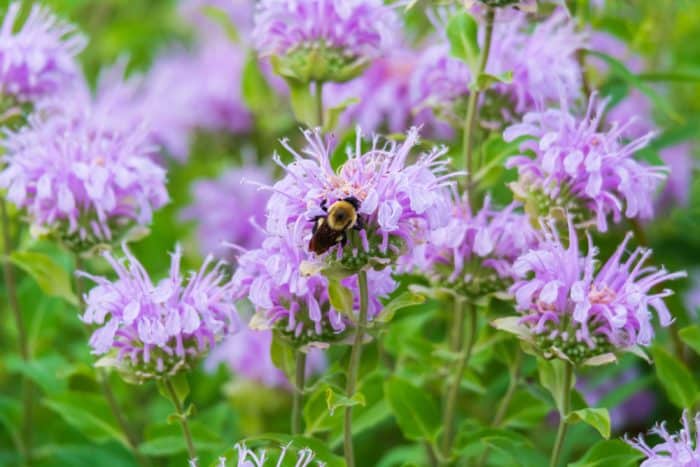
Native Seed Suppliers in Ontario
I was delighted to discover a number of seed suppliers in Ontario. Here are some that I was able to find easily:
| Company | Location |
|---|---|
| Bee Kissed Seeds | Hamilton/Stoney Creek |
| Hana Earth Gardens | Toronto |
| Hidden Habitat | Kilworthy (not far from Gravenhurst) |
| Howling Hound Farms | Harrow (south of Windsor) |
| Native Plants in Claremont | Pickering |
| Northern Wildflowers | Lively (near Sudbury) |
| OSC – Ontario Seed Company | Waterloo (be mindful of seed source) |
I’d like to keep my garden as truly native to our area as possible so it’s important to me that I find a supplier at least based in Ontario: the closer they are to my region the better. Fortunately it didn’t take me long before I stumbled upon Northern Wildflowers.
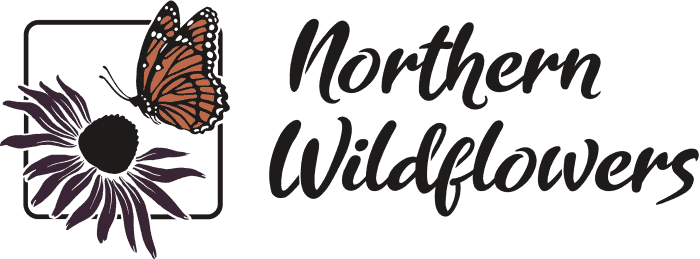
Why I Chose Northern Wildflowers for My Seeds
I chose Northern Wildflowers for my seeds for these reasons:
- I was able to confirm that a good many of their seeds are native where I am (or just a little south) using my Grey-Bruce Vascular Plant List. I like that they’re a little north of me since that implies that the plants will be able to tolerate the unique North Bruce Peninsula climate.
- Their selection is impressive – and just enough that I didn’t have to shop at multiple places.
- They source their seed’s from their own stock plus a number of contract growers. This means that they’re not just resellers of seed from “foreign” sources.
- They show how they harvest and process the seed. It’s fascinating so be sure to follow them on Socials where they share loads of information.
Does Your Seed Need Pre-Treatment to Germinate?
Before you decide which method of seed sowing you’ll do, it’s a good idea to determine what your seeds need to germinate. Some seeds, often annual flowers, can land and germinate with no special needs. These are great selections for beginners or introducing children to the wonders of gardening. Some seeds need a little help to ensure germination; this help is called pre-treatment.
Pre-treatment is our way of mimicking natural germination processes in the hope of increasing your chances of successful germination. Pre-treatment can be achieved by:
- Cold stratification – This is a fancy term for over-wintering. Many perennial seeds need a period of cold temperatures or temperature variations (seasons) to prepare them for germination. I’ll explain more about how this can be done below.
- Scarification – This is needed for seeds with thick outer coats and can be achieved by soaking or using an abrasive action to break through the tough coat.
- Soaking – Similar to soaking your dried beans before cooking, this process softens the seed coat.

Many of the native plants in my area need cold stratification. This can be achieved by:
- Winter Sowing is when you plant seeds in containers and place them covered outdoors
- Direct Sowing in late fall by planting seeds directly in your garden.
- Sowing seeds into the snow.
- Fridge stratification (get proper term) – placing the seeds in damp paper towels and putting them in your fridge or freezer for 6 – 13 weeks.
My Method for Planting Native Wildflower Seeds
I’m a fairly lazy gardener and I had A LOT of seeds to plant so direct sowing seemed to be my best option. Here’s how I did it.
1. Determine which seeds need cold stratification.
A quick look through my seed packs from Northern Wildflowers made this job easy as they show you right on the label if your seeds need pre-treatment. Of course any seed can be sown before (or in) winter so my plan was to sow everything on one day.
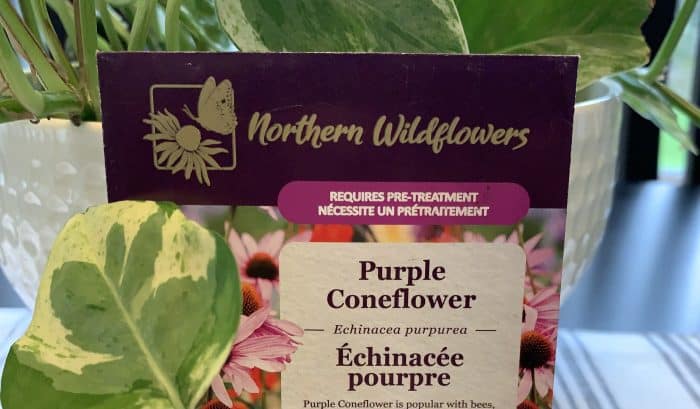
2. Determine the placement/style of your planting.
We’re focusing our seed planting around the perimeter of our clearing and along the driveway. While these are more wild areas (compared to our foundation beds), we chose to have our plants appear in waves rather than all mixed together as a meadow would appear. This will mean à little bit of extra work but I think it will be worth it.
3. Watch the weather!
You want to do your direct sowing when the weather cools and cools and you start having a few frosty mornings. For us that time usually comes in November. Luckily there are also some lovely sunny days then so it’s a perfect time to put on a thick sweater and get outside. Nov 5 was that day for me.
4. Prepare Your Native seeds for planting.
While I could have placed my native plant seeds directly on the ground, I thought it would be a nice gesture to put them in a little soil to give them a nice little bed for winter. Yes, I know that sounds a little woo woo… but that’s how I roll sometimes. I put a few handfuls of triple mix into a bowl, dumped my seeds in with the soil and stirred up the contents with my hands.
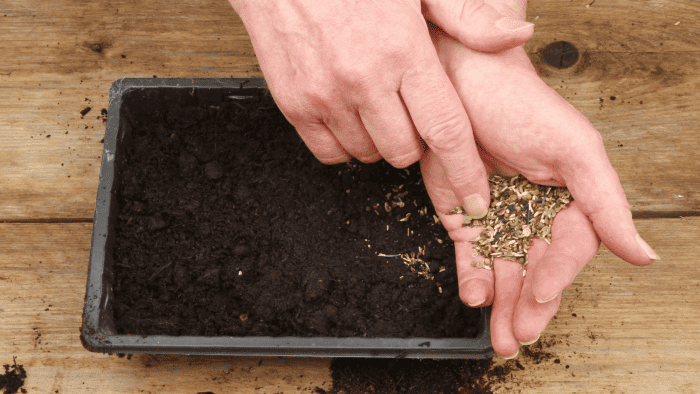
As I worked, I was often amazed how tiny the seeds can be – some of them were no bigger than the pointy end of a pin! Then of course l’d marvel at the dedication of the growers, collectors and sorters of the seeds I was now holding. Seriously, how can these wee little morsels grow into real plants?!
Needless to say this job took me a while because I was constantly stopping to examine something.
5. Sow The Native Plant Seeds
Once the seeds were well blended with the soil, I’d walk with the bowl over to the edge of the clearing, make a little space in the taller grass, scratch up the ground a bit, then place a handful of the mixture onto the ground, and pat it down. Then I’d re-fluff the grass around it for little protection. I’d get up, take a few paces and repeat the sowing process until I ran out of the seed/soil mixture.
I repeated the process with each seed variety until I was done.
What I Planted Using The Direct Sow Method
Like I reported in Planting Our First Native Garden, here’s what I planted, where and it’s “native” status:
Perimeter of Clearing
| Plant | Status | Note |
| Boneset Eupatorium perfoliatum | Common | |
| Culver’s Root Veronicastrum virginicum | Ontario Native | Unconfirmed local status, I just love this plant! |
| Square-Stemmed Monkey Flower Mimulus ringens | Common | Come on! It’s got monkey in the name! How can I NOT plant this?! |
| Black Cohosh Cimicifuga racemosa | Ontario Native | Unconfirmed local status. aka Actaea racemosa |
| Cup Plant Silphium perfoliatum | Introduced Native | |
| New York Ironweed Vernonia noveboracensis | Not Native | Status in Ontario is disputed. |
| Blue False Indigo Baptisia australis | Not Locally Native | I’ve checked a number of maps/sources and none seem to agree. aka Blue Wild Indigo |
Along Driveway Edges – One side gets good sun, the other is mostly in shade.
| Plant | Status | Note |
| White Wild Indigo Baptisia alba | Not Locally Native | I’ve checked a number of maps/sources and none seem to agree. |
| Great Blue Lobelia Lobelia siphilitica | Rare | |
| Purple Coneflower Echinacea purpurea | Introduced Native | |
| Bottle Gentian Gentiana andrewsii | Uncommon Native |
Various Other Locations
| Plant | Status | Note |
| Canada Anemone Anemone canadensis | Common | In front foundation garden |
| Cardinal Flower Lobelia cardinalis | Common | In front foundation garden |
| Common Milkweed Asclepias syriaca | Common | In the roadside ditch |
| Swamp Milkweed Asclepias incarnata | Common | In the roadside ditch |
| Wild Blackberry Rubus allegheniensis | Common | On the backyard slope |
| Wild Lowbush Blueberry Vaccinium angustifolium | Uncommon | On the backyard slope |
Believe it or not I held back some seeds so I could try Winter Sowing. Stay tuned on that!
I wish I would have taken more care with the blackberry and blueberry seeds. From what I’ve read since sowing them they can be tricky to start from seed. I’ll see what happens and do better if I need to make a second attempt.
Whew! As you can see, that’s a lot of plants that I was able to plant in a relatively short period and for very low cost. Just think about that … each seed packet costs about $4.00 ($68.00 for the 17 packages) and contains the potential for 100’s of plants. Even if only a fraction of the seeds germinate and take some time to establish, I think I’m still well ahead financially. I’m really interested to see the results compared to winter sowing – and then the survival rate of everything.
This should give me enough of a start on the landscaping/native gardens that I can focus most of my attention on getting the vegetable gardens started in the spring.
2 thoughts on “Starting Native Plants From Seed”
Leave a Reply
Recent Posts
7 Totally Selfish Reasons to Choose Native Plants for Your Gardens
Grab a cup (or glass) of your favorite beverage, and let's delve into what I’ve learned so far about why it's incredibly important and wildly selfish to embrace landscaping with locally native...
Exploring the differences, benefits and drawbacks of Broadcast Sowing and Frost Seeding for Native plants.

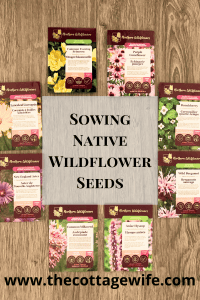
We have a small cutflower farm in SK, but one of our goals is to have a small native garden that we can eventually offer bouquets built entirely of native plants. Hopefully it can help people be more familiar with them and appreciate their beauty and learn more about them and their animal counterparts.
That sounds amazing! I can imagine how beautiful those bouquets would be! I hope you stay in touch and let me know how your goal progresses.